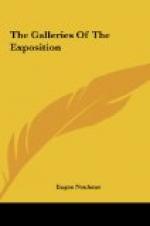It seems only rational that, with the notorious absence of any important permanent exhibition of works of art on the Pacific Coast, an effort should have been made to present within the exhibit the development of the art of easel painting since its inception, because it seems impossible to do justice to any phase of art without an opportunity of comparison, such as the exposition affords. The retrospective aspects of the exhibition are absorbingly interesting, not so much for the presentation of any eminently great works of art as for the splendid chance for first-hand comparison of different periods. Painting is relatively so new an art that the earliest paintings we know of do not differ materially in a technical sense from our present-day work. Archaeology has disinterred various badly preserved and unpresentable relics of old arts such as sculpture and architecture. It is little so with pictures. Painting is really the most recent of all the fine arts. It must seem almost unbelievable that the greatest periods of architecture and sculpture had become classic when painting made its début as an independent art. It is true enough that the Assyrians and Egyptians used colour, but not in the sense of the modern easel painter. We are also informed, rather less than more reliably, that a gentleman by the name of Apelles, in the days of Phidias, painted still-lifes so naturally that birds were tempted to peck at them, and we know much more accurately of the many delightful bits of wall-painting the rich man of Pompeii and Herculaneum used to have put on his walls, but the easel painting is a creation of modern times.
The sole reason for this can hardly be explained better than by pointing out the long-standing lack of a suitable medium which would permit the making of finer paintings, other than wall and decorative paintings. The old tempera medium was hardly suited to finer work, since it was a makeshift of very inadequate working qualities. Briefly, the method consisted of mixing any pigment or paint in powder form with any suitable sticky substance which would make it adhere to a surface. Sticky substances frequently used were the tree gums collected from certain fruit-trees, including the fig and the cherry. This crude method is known by the word “tempera,” which comes from the Latin “temperare,” to modify or mix, and denotes merely any alteration of the original pigment. Tempera painting, as the only technique known, was really a great blessing to the world, since it prevented the wholesale production in a short time of such vast quantities of pictures as the world nowadays is asked to enjoy. I am not so sure that the two brothers, the Flemish painters Hubert and Jan van Eyck, who are said to have given us the modern oil method, are really so much deserving of praise, since their improved method of painting with oils caused a production of paintings half of which might much better have remained unpainted. The one thing that can be said of all paintings made before




